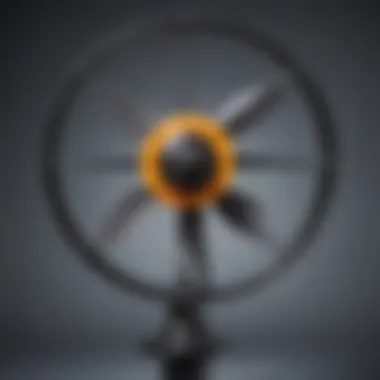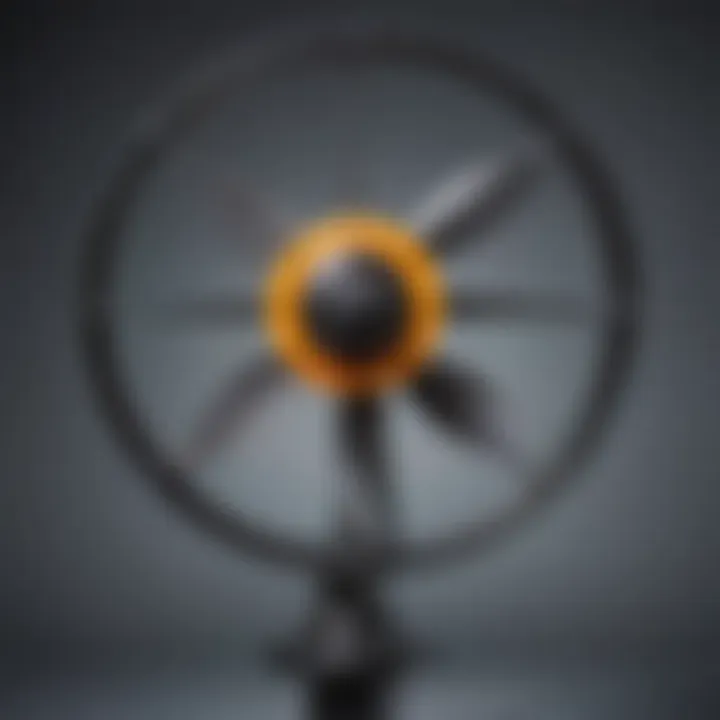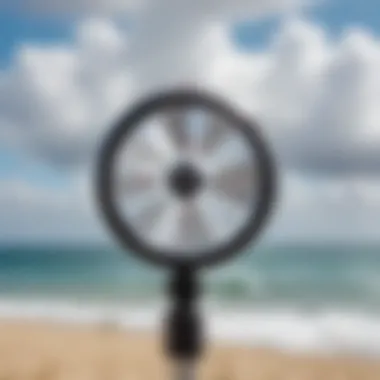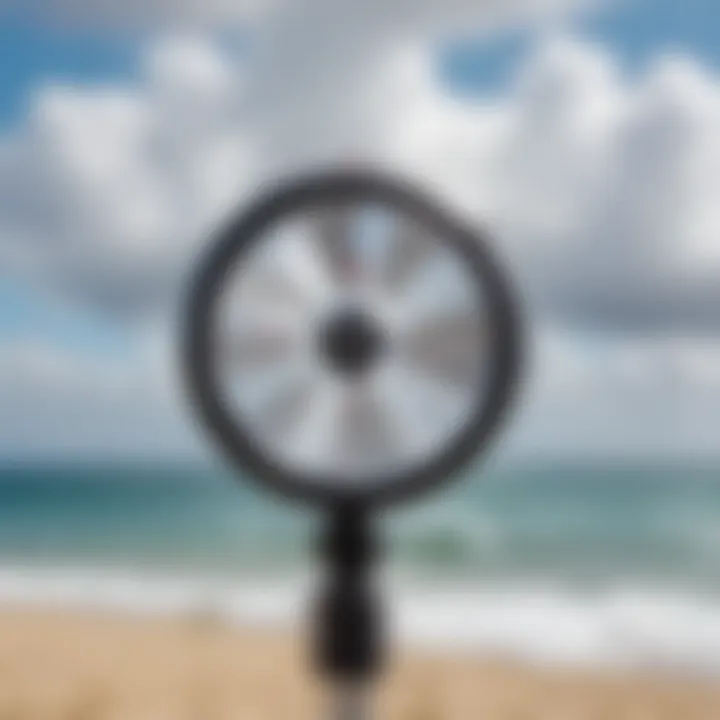Types of Anemometers: A Comprehensive Overview


Intro
Wind speed and direction measurement is paramount, especially for those who live for the thrill of watersports. Whether you’re zipping across the waves on a surfboard or harnessing the wind in a kite, understanding the nuances of wind conditions can make or break your day on the water. This section sets the stage for a deep dive into the different types of anemometers, the trusty tools that help you gauge the winds. From the simplicity of handheld models to sophisticated digital devices, each type offers unique features tailored to specific environments and activities.
In this guide, we will explore how different anemometers operate, what makes each one special, and why selecting the right device is crucial for both enthusiasts and professionals alike. As athletes and instructors in watersports navigate the ebbs and flows of the wind, these tools become valuable allies.
Gear Essentials
Top Picks for Watersports Equipment
It’s a no-brainer that the right gear can elevate your performance. When it comes to measuring wind, some anemometers stand out due to their reliable performance and practicality in various conditions. Here are a few devices that might pique your interest:
- Kestrel 5500 - This handheld anemometer incorporates smart technology and can measure not just wind speed but also temperature and humidity. Its size makes it easy to carry around.
- David White 2010 - Designed for outdoor use, it connects seamlessly with your smartphone for data logging. This level of detail is invaluable for those analyzing their performance.
- Skywatch BL - A compact digital anemometer known for its accuracy, perfect for kite surfers who need quick measurements in changing conditions.
- Ambient Weather WS-2902C - More than just an anemometer, this weather station can give a comprehensive overview of your local wind patterns, helping you plan your outing.
Each of these devices comes with its own advantages, whether it’s portability, multi-functionality, or advanced technology.
Maintenance and Care Tips for Gear
Taking proper care of your anemometer can greatly extend its lifespan. Here are some tips:
- Keep it clean - Regularly wipe down the device to avoid buildup of salt or dirt, especially after a day on the water.
- Store it properly - Make sure to keep your gear in a safe place, away from moisture and extreme temperatures when not in use.
- Calibrate your device - Check the manufacturer's guide regarding calibration. An updated reading will ensure you get accurate measurements.
- Battery checks – Always keep an eye on battery life, especially before heading out for a long day.
Taking these steps can make a huge difference over time.
Techniques and Tips
Beginner Tips for Each Watersport
- Surfing - Always check the wind readings before you hit the water. Good offshore winds can lead to cleaner waves, making your surf more enjoyable.
- Kitesurfing - On windy days, note wind strength and direction when setting up your gear. It’s essential to have the right kite size for the wind conditions.
- Paddleboarding - Light wind can be your friend on calm days. Always face into the wind when paddling out to avoid getting blown off course.
Advanced Techniques for Skill Enhancement
- Analyze data - Use your anemometer readings in conjunction with performance stats to track improvements over time.
- Wind patterns - Recognize how the landscape affects wind, which can give you a competitive edge. Areas near cliffs, mountains, or buildings often experience shifts in wind direction.
- Timing your sessions - Learning to predict favorable wind conditions can lead to more successful outings. Keeping tabs on local patterns will elevate your skill.
"To ride the wind is to feel free, but to know its ways is to master the ocean."
With the right knowledge and tools, anyone can harness the power of the wind and enhance their experience on the water.
Understanding Anemometers
Understanding anemometers is vital for anyone interested in wind measurement, particularly watersports enthusiasts. Wind is a constant player in activities like surfing, kitesurfing, or paddleboarding. Having precise and timely wind data can turn an average day on the water into a thrilling adventure or avoid potential dangers. Thus, the relevance of selecting the right anemometer cannot be overstated. It’s not just a gadget; it’s a key to unlocking the conditions of the elements you’ll face.
Definition and Purpose
An anemometer is a device that measures wind speed and direction. The name stems from the Greek ‘anemos,’ which means wind. While most of us think of this tool as a simple instrument that spins in the breeze, its purpose is far deeper. Anemometers convert wind movement into readable data, providing crucial information for various applications, from agriculture to aviation.
A common style, the cup anemometer features three or four cups mounted on horizontal arms. As the wind blows, these cups catch the wind and rotate, allowing sensors to gauge the speed based on rotation frequency. Moreover, high-tech versions, such as hot-wire anemometers, use heat dissipation from a thin wire to determine wind speed with pinpoint accuracy, vital for sensitive research.
Why should you care? Because in the context of watersports, the difference between a light breeze and a strong gust can mean everything. Knowing how fast the wind is blowing can determine the safety and enjoyment of your activities. Whether you're fine-tuning your kiteboarding skills or just want to catch the best waves, understanding your anemometer's readings will significantly influence your performance and enjoyment.
Importance in Watersports
In watersports, where conditions can fluctuate rapidly, an anemometer serves as a sailor’s best friend. Windsurfers, surfers, and paddleboarders often rely on these tools to assess the day's viability. For example, winds that are too light can lead to frustration, whereas excessively strong winds can create hazardous conditions. Hence, knowing the wind speed becomes paramount.
An anemometer is indispensable not just for personal use but also for instructors who need to assess conditions for students. Having an accurate reading prevents accidents and ensures everyone has a safe and enjoyable time on the water. Furthermore, for gear reviewers and manufacturers, precise wind data can aid in developing equipment that performs well under varying conditions.
"A good anemometer does more than just measure wind; it measures the potential for adventure on the water."
Investing in a reliable anemometer means enhancing your planning. You can check forecasts and adjust your timing based on real-time data, maximizing your time spent on the water. Understanding anemometers creates deeper insights; it shifts your awareness from just feeling the wind to knowing it. This kind of knowledge can elevate your performance and deepen your connection with the elements that guide your watersport experience.
Classifying Anemometers
Classifying anemometers is crucial because it allows users to select the right instrument for their needs based on specific functionalities. With various designs and measurement types, each anemometer possesses unique advantages that cater to particular circumstances, making it essential to understand these different classifications. Furthermore, this understanding empowers enthusiasts, such as surfers, paddleboarders, and kitesurfers, to make informed decisions that align with their activities and conditions.
Based on Operating Principles
Mechanical Anemometers


Mechanical anemometers operate on the principle of wind behavior and response to physical structures. The key characteristic of these devices is their reliance on physical movement to determine wind speed. For instance, a classic cup anemometer consists of several cups attached to horizontal arms, which rotate as wind blows against them. This rotation drives a gauge or dial, indicating wind speed.
The popularity of mechanical anemometers lies in their straightforward operation and maintenance. They're often favored by beginners and smaller operators since they don’t require extensive user training. However, one should note their limitations. Mechanical versions can struggle in extreme conditions, like heavy gusts or turbulent winds, potentially giving unreliable readings. Yet, when calibrated properly, they provide reasonably accurate data, making them reliable for casual users.
Digital Anemometers
Digital anemometers are known for their advanced functionality. Their operation often involves electronic sensors that provide quick and precise measurements. One prominent feature of digital anemometers is their ability to display results in various formats, like meters per second or miles per hour, making them versatile and user-friendly.
These instruments shine in professional settings, where accuracy is paramount. The ability to store data for subsequent analysis adds to their appeal for many in the water sports community. Yet, one must consider that digital models might come with a higher price tag and often require a power source, which may not be ideal in all scenarios.
Based on Measurement Type
Anemometer for Wind Speed
Anemometers specifically designed for wind speed focus solely on capturing how fast the wind moves. This analysis is particularly relevant for activities where knowing the speed of wind is vital, such as in kitesurfing or surfing, where conditions can change rapidly and drastically.
The typical characteristic of wind speed anemometers is their calibration for sensitivity and precision. They provide immediate feedback, which can be a game changer when making split-second decisions on the water. However, it is essential to note that these devices may not provide full context about overall wind conditions, especially when not paired with wind direction readings.
Anemometer for Wind Direction
Anemometers that measure wind direction complement those focused on wind speed. Knowing which way the wind is blowing can be just as essential for athletes and enthusiasts alike. In kiteboarding or surfing, understanding wind direction helps in choosing the best spots for these actions and planning maneuvers effectively.
These models typically feature a vane or similar mechanism to ascertain wind direction. Although they're invaluable, they can sometimes lag slightly as they might not react as quickly to rapid shifts in wind patterns. Users should ensure that they remain attentive to both measurements for a comprehensive understanding of the conditions at hand.
"Having the right equipment is half the battle—you'll find that your performance can significantly improve when you know exactly what to expect from the wind."
Mechanical Anemometers
Mechanical anemometers have carved a niche for themselves in the world of wind measurement, thanks to their simplicity and durability. These devices operate based on mechanical principles, meaning they do not require any electrical power or complex digital systems to function. For the target audience of surfers, paddleboarders, kitesurfers, instructors, and gear reviewers, understanding mechanical anemometers is crucial, as they offer reliable and consistent readings when assessing wind conditions before heading out onto the water.
Cup Anemometers
Cup anemometers are one of the most popular types within the mechanical category. Comprising three or four cups, usually attached to a vertical axis, these instruments measure wind speed by using the force of the wind to spin the cups. Their design is strikingly simple yet effective—imagine a merry-go-round that spins faster with stronger winds.
One of the notable benefits of cup anemometers is their relatively low cost, making them accessible to both novices and seasoned professionals alike. They can be found adorning rooftops and weather stations, as they provide consistent wind speed data essential for predicting conditions. Even a slight increase in wind velocity can send the cups whirling, offering surfers and kitesurfers vital information about whether it’s time to hit the waves or wait things out.
However, users should also be aware of their limitations. Cup anemometers may struggle in turbulent wind conditions or when placed close to other structures that can obstruct airflow. Therefore, their installation location is key for accurate readings.
Vane Anemometers
Another common type are vane anemometers, which are akin to small weather vanes. They consist of a rotating blade or fin that aligns with the wind direction while measuring speed simultaneously. Their engineering enables them to provide real-time data about both wind speed and direction, which is of utmost importance for those engaged in wind-dependent activities.
Vane anemometers are often favored for their sensitivity to lower wind speeds, offering insights that cup anemometers might miss, especially in subtle breezes that could signal prime surfing conditions. Because they calculate information in two dimensions, these instruments can be especially helpful for instructors teaching newcomers who need to understand how subtle shifts in wind direction can affect their approach on water.
Still, one consideration to keep in mind is that vane anemometers are generally less robust than their cup-based counterparts, making them more susceptible to damage from the elements if not properly maintained.
Hot-Wire Anemometers
Hot-wire anemometers are a bit of a different beast. They operate on a principle involving temperature changes. A fine wire is heated, and as air flows over it, the cooling effect of the wind alters its temperature. By measuring this change, the anemometer can accurately determine wind speed.
These devices excel in environments where precision is key—think of competitive kayaking or windsurfing training sessions where exact measurements can mean the difference between a good run and a bad one. While hot-wire anemometers deliver high accuracy, they come with a steeper learning curve and generally higher costs, making them less ubiquitous than cup or vane types.
They are sensitive to environmental factors; changes in humidity or temperature can impact their readings. That said, for professionals who want to push their limits in wind-related sports, understanding how these devices can refine their technique is invaluable.
"A solid grasp of how mechanical anemometers work is fundamental for any water-based sport."
In summary, mechanical anemometers provide essential insights for those whose activities are intricately tied to the whims of the wind. Whether opting for the simple, cost-effective cup anemometer, the directionally insightful vane anemometer, or the precise hot-wire anemometer, each brings a unique value. Choosing the right one can enhance a water sports experience and ensure safety while engaging with nature.
Digital Anemometers
Digital anemometers represent a significant evolution in wind measurement technology, making them essential tools for a variety of applications, particularly in watersports. Unlike traditional mechanical types, digital anemometers offer enhanced accuracy and real-time data display, which can be invaluable for surfers, paddleboarders, and kitesurfers who rely on precise wind conditions to optimize their performance. Furthermore, the user-friendly interfaces of these devices often feature illuminated displays and various measurement modes, appealing to enthusiasts unfamiliar with complex technicalities.
One of the standout benefits of digital anemometers is their ability to record and store data. Many models are equipped with memory functions, enabling users to track wind patterns over time. This capability is crucial for athletes and instructors looking to analyze performance and strategize their next outing. Additionally, portability is a hallmark of many digital models, allowing users to carry them easily to different locations, thus ensuring they can measure wind conditions wherever they go.
Portable Digital Anemometers
Portable digital anemometers have become widely favored among water sport enthusiasts. Designed for mobility, these devices are lightweight and compact, making them ideal for on-the-go use. Many of these anemometers fit comfortably into a pocket, yet they pack a punch in terms of functionality. They generally utilize small, battery-powered fan blades or pressure sensors that can provide readings in seconds.
When considering a portable model, factors like battery life and sensor accuracy play a pivotal role. Users will often prioritize a device that not only offers quick readings but also remains powered throughout long sessions on the water. Features such as backlit screens and rugged casings increase usability and durability, ensuring that regardless of weather conditions, surfers or paddleboarders can rely on their instruments.


Moreover, real-time data display helps in making quick on-the-spot decisions. For example, understanding gust patterns during a surfing session can make the difference between a thrilling ride and a missed opportunity. In this context, getting direct feedback from a portable digital anemometer adds significant value.
Advanced Data Logger Anemometers
On the other end of the spectrum, advanced data logger anemometers cater to serious hobbyists and professionals who demand a deeper analysis of wind conditions. These sophisticated instruments not only measure wind speed and direction but also store extensive historical data, making them invaluable for anyone looking to dive into detailed assessments.
Advanced models often come equipped with features such as:
- Large memory capacity: Users can record data for long periods, allowing for comprehensive trend analysis.
- Multiple sensors: Some devices utilize various sensors to measure temperature, humidity, and other environmental factors alongside wind metrics.
- Software integration: Many advanced anemometers can connect with computer software for data visualization and analysis.
For instructors and athletes, this data can be vital in formulating a training regimen tailored to wind conditions. For example, if a rider notices patterns linking their performance to specific wind speeds or directions, they could effectively plan training sessions to coincide with those conditions.
"In the world of watersports, understanding the wind isn’t just helpful; it’s essential. The right digital anemometer can be the difference between a successful session and a frustrating day."
For further details about the evolution and types of anemometers, check out Wikipedia and Britannica.
Additionally, you might find discussions on this topic in forums like Reddit or communities on Facebook.
By understanding the forms and capabilities of digital anemometers, surfers and instructors can optimize their experiences on the waves.
Applications of Anemometers
Anemometers serve a multitude of purposes across different industries. Their role is not limited to just measurement; they also contribute significantly to safety, research, and planning. Knowing how to accurately measure wind speed and direction can be a game changer for activity planning, particularly in watersports, meteorology, and aviation.
By understanding the specific applications of anemometers, enthusiasts can make better-informed decisions about their activities. From selecting the perfect day to hit the waves to ensuring safe flying conditions for airplanes, this knowledge is invaluable.
In Meteorology
In meteorology, anemometers are fundamental devices. They are used to collect wind data that informs weather forecasting and climate studies. Meteorologists rely on this information to predict storm patterns and other significant weather changes. The accuracy of wind measurements can mean the difference between a safe day outdoors and a warning for strong winds.
"Understanding wind behavior can save lives and prevent property damage."
In practical terms, devices like cup anemometers and hot-wire anemometers are utilized in various meteorological stations. These instruments help track wind patterns over time, which aids in climate research and long-term forecasting. As technology evolves, meteorological anemometers increasingly integrate smart technology, allowing for real-time data transmission and analysis.
In Aviation
Aviation heavily relies on precise wind data for flight safety and efficiency. Anemometers are utilized at airports to ensure that pilots are well-informed about wind conditions before and during flights. Factors such as wind shear – a rapid change in wind speed or direction – are critical for takeoff and landing operations.
When pilots receive accurate information about wind speed, they can adjust their flight plans accordingly, be it taking off toward the wind for a safer lift-off or avoiding areas of turbulence. The use of portable digital anemometers in aviation settings helps pilots and air traffic control teams manage these conditions effectively.
In Marine Sports
For enthusiasts like surfers, paddleboarders, and kitesurfers, anemometers are essential tools that can directly impact their experience. Knowing the wind speed and direction allows athletes to determine the best times and locations for their activities.
Moreover, various anemometers are tailored specifically for marine use. For instance, handheld portable anemometers provide real-time data about wind conditions right on the water. This can help in making split-second decisions during kitesurfing or sailing, ensuring safety and enhancing performance.
In addition to safety, understanding wind data can elevate the overall experience and success of marine ventures. By knowing the right wind conditions, participants can maximize their fun and skill development, making the sport not only safer but also more enjoyable.
Technological Advancements in Anemometry
The world of anemometry has come a long way since the rudimentary devices of yesteryears. The importance of technological advancements in this field cannot be overstated. For surfers, paddleboarders, kitesurfers, and instructors who rely on precise wind measurements, these innovations offer not only accuracy but also the convenience and better functionality.
Integration with IoT
One of the most transformative shifts in anemometer technology is the integration with the Internet of Things (IoT). By connecting anemometers to the internet, users can now access real-time data from anywhere. This means that instead of relying on static measurements, watersport enthusiasts can get live updates about wind conditions, thus enabling them to make informed decisions on the go.
A few notable benefits include:
- Remote Monitoring: Users can monitor wind speeds from home via mobile applications, allowing for timely adjustments to their schedules.
- Data Sharing: Athletes and instructors can share valuable data with peers, helping foster a community of informed decision-making.
- Predictive Analytics: IoT-enabled devices can analyze patterns in wind data and offer predictive insights, like when the best wind conditions may occur.
Development of Smart Anemometers
The rise of smart anemometers marks a significant leap forward. These devices are not simply digital versions of their predecessors; they often come equipped with sensors and features that enhance their usability for the modern athlete. For example, many smart anemometers incorporate machine learning algorithms that adapt and learn from user behavior. As such, they can suggest optimal times for training or sports activities based on historical data.
Key features of smart anemometers include:
- Automated Calibration: Reduces the manual calibration effort needed, making them user-friendly, especially for those who may not have technical knowledge.
- Enhanced Connectivity: Often provide seamless integration with other devices and apps, creating a comprehensive ecosystem for athletes.
- Durability: Many smart models are built to withstand harsh environmental conditions, making them ideal for outdoor sports.
"The advent of smart anemometers is not just a trend; it signifies a shift toward a more connected and responsive sports environment."


In summary, the advancements in anemometry through IoT integration and the development of smart devices present significant benefits for enthusiasts of wind-dependent sports. The scope for data utilization and ease of access creates a more dynamic and informed sports practice, crucial for refining skills and enhancing performance.
Choosing the Right Anemometer
Selecting the appropriate anemometer can greatly influence the experiences of surfers, paddleboarders, kitesurfers, and instructors alike. It's not just about picking a device off the shelf; it’s about recognizing how various features can align with specific needs and activities. With the right tool, wind assessments become substantially more accurate, leading to better decision-making in various watersport settings. An informed choice in this area could mean the difference between a thrilling day on the water and an unexpectedly rough ride.
Factors to Consider
When it comes down to choosing the best anemometer for your needs, there are a couple of vital factors worth pondering.
Accuracy and Precision
Accuracy and precision stand tall when it comes to wind measurement. The ability to gauge wind speed and direction with a high degree of reliability is paramount. An anemometer that boasts high accuracy can consistently deliver results that are close to the true wind conditions. This is crucial for pro surfers or instructors who depend on precise data to ensure safety and optimize performance.
One of the essential characteristics of accurate anemometers is their calibration capability. Regular calibrations ensure that these devices maintain their reliability over time, allowing users to have confidence in the readings, especially under changing conditions.
While some models might sacrifice accuracy for a lower price tag, investing in a precise anemometer often pays off in the long run. On the flip side, the trade-off could be in cost, as advanced accuracy might lead to a higher initial investment. Yet, the assurance that comes with exact data in high-stakes situations typically outweighs this drawback.
Environmental Resistance
When you're out on the water, the last thing you want to worry about is your equipment getting damaged by the elements. This is where environmental resistance comes into play. An anemometer designed to withstand harsh weather conditions – be it heavy rain, salty spray, or intense sunlight – is a must for watersports enthusiasts.
Such devices are often built with durable materials that offer protection against moisture and UV rays. This characteristic not only prolongs the life of the instrument but also helps in ensuring consistent readings without interference from external factors.
Choosing an anemometer with solid environmental resistance can, however, mean an increase in weight and bulkiness. It’s a balancing act. While sturdier models may come at a premium in terms of size and cost, their ability to function reliably in tough conditions often makes them the more sensible choice for dedicated watersport users.
Recommended Models for Watersports
In the vast ocean of anemometer options, certain models stand out as especially beneficial for those engaged in watersports.
- Kestrel 5500: Known for its accuracy and rugged design, this portable device is a favorite among windsurfers and sailors alike. Its built-in data logging offers the advantage of tracking conditions over time, making it easier to analyze trends.
- Extech AN100: This little performer is often favored for its user-friendly interface and decent price point. Perfect for paddleboarders who want reliable measurements without breaking the bank.
- Davis Instruments 7911: A strong choice for kitesurfing enthusiasts, known for its solid environmental resistance and ability to measure both wind speed and direction. It holds up well against the elements, radiating reliability.
- Proster Digital Anemometer: This is a popular pick for its affordability while still providing accurate readings. Great for beginners who are just starting to explore the wonders of wind sports.
In summary, choosing the right anemometer involves careful consideration of factors like accuracy, environmental resistance, and personal preferences regarding budget and usage. With these elements in mind, anyone passionate about watersports can pick a tool that enhances their overall experience.
Maintenance of Anemometers
Proper maintenance of anemometers is crucial to ensure they provide reliable and accurate measurements. For surfers, paddleboarders, kitesurfers, and instructors alike, knowing the wind conditions is key to enjoying their time on the water. Regular upkeep maximizes the lifespan of these instruments and can help prevent costly repairs down the line.
Without regular maintenance, an anemometer can develop inaccuracies that may lead to poor decision-making in outdoor activities. A faulty reading can be the difference between a great day out and an unexpected struggle against unexpected wind conditions. Hence, understanding the importance of maintenance serves not just the equipment but also the safety and enjoyment of those who rely on wind measurements.
Routine Checks
Routine checks are the first line of defense in maintaining anemometers. Regularly inspecting the device can help ensure that it remains functional and reliable. Here are some key aspects to focus on during these checks:
- Visual Inspection: Look for any signs of physical wear or damage. Components such as cups or sensors should be intact and free of obstructions.
- Lubrication: If the anemometer has moving parts, occasional lubrication may be needed for smoother operation, especially after exposure to saltwater.
- Battery Check: For digital models, keeping an eye on battery levels is vital. A sudden drop in power can lead to unreliable readings and should be addressed promptly.
- Cleaning: Dust, debris, and moisture can interfere with the anemometer's precision. Regular cleaning, particularly of the sensors and rotating parts, helps in avoiding performance dips.
By conducting these simple checks, users can catch issues before they escalate, ensuring that data remains accurate as they ride the waves or navigate other wind-dependent activities.
Calibration Procedures
Calibration is a necessary step in maintaining the accuracy of any anemometer. Calibration should be performed periodically, depending on usage frequency and environmental conditions. Here’s a straightforward outline of what this involves:
- Establish a Baseline: Use a calibrated reference anemometer to create a baseline measurement in similar conditions. This will help you understand how accurately your device is performing.
- Compare Readings: Take readings from both your anemometer and the reference device simultaneously. Note any discrepancies and analyze the data.
- Adjustment: If significant differences in readings are noted, consult the manufacturer's guidelines for adjusting the calibration of your specific anemometer model. Some may allow adjustment via a built-in function, while others might require manual tweaks.
- Record Calibration Data: Keeping a log of calibration dates and results creates a clear historical record. This information becomes useful for troubleshooting in the future.
"Failing to prepare is preparing to fail."
Maintaining an anemometer isn't just about the device; it's about fostering a deeper connection with the elements. Surfing or kitesurfing in unpredictable winds can be daunting, but keeping your measurements trustworthy ensures exhilarating adventures rather than unwelcome surprises.
Future of Anemometry
The future of anemometry holds vast potential to revolutionize how we measure and interpret wind-related data. This significance is particularly pertinent for surfers, paddleboarders, kitesurfers, and those who instruct these water sports. Advancements in technology will undoubtedly enhance their ability to assess wind conditions effectively, allowing for improved decision-making, safety, and performance on the water.
The rapidly evolving landscape of digital tools and IoT integration presents a myriad of opportunities. With ever-increasing demand for real-time data, anemometers are anticipated to become lighter, smarter, and more user-friendly. These qualities will cater not just to professionals, but also to recreational enthusiasts aiming for self-sufficient assessments of wind conditions.
Emerging Trends
A notable trend in the anemometry sector is the push towards more compact design while still enhancing capabilities. Miniaturized devices are becoming increasingly popular, often seamlessly fitting into existing gear without adding bulk. For instance, imagine a portable device that can easily attach to a kite or paddleboard, providing instant readouts of wind speed and direction through Bluetooth connectivity to your smartphone.
Furthermore, the integration of machine learning algorithms is taking center stage. Modern anemometers, equipped with AI, can analyze historical data and current conditions to predict future weather patterns, affording users a strategic edge. This technology's potential extends beyond just immediately perceivable winds, offering insights that could shape long-term planning for events or leisure activities.
Potential Innovations
Innovative strides in anemometry might focus on durability and environmental resistance. For those engaging in high-adrenaline sports on the water, devices that can withstand harsh marine conditions without compromising accuracy are essential. Think about an anemometer built from advanced composite materials tailored to resist saltwater and extreme temperatures, offering both longevity and precision.
Another promising innovation is the potential for enhanced data sharing capabilities. Imagine a community of surfers linked through a smart network of anemometers that shares real-time wind data across a broad area. This would not only empower individuals with localized insights but also foster a spirit of collaboration and safety among the water sports community.



